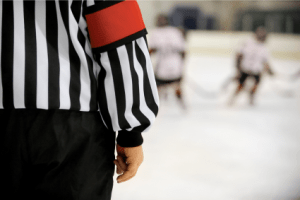What is the NCAA?
The National Collegiate Athletic Association (NCAA) is a voluntary organization through which American colleges and universities govern their athletic programs. It comprises more than 1,250 institutions, conferences, organizations and individuals.
What do I need to do to compete in the NCAA?
In order to compete in the NCAA you must graduate from high school, write the SAT or ACT, register with the NCAA Clearinghouse, meet NCAA academic standards, remain academically and athletically eligible to compete and be admitted to an NCAA institution.
How many universities offer hockey programs?
There are approximately 58 Division I, 4 Division II, and 74 Division III hockey programs.
B. Division I, II and III
What is Division I?
Division I is the highest level of athletic competition in the NCAA. Athletic programs at
Division I universities can offer financial aid or scholarships based solely on athletic ability.
What is Division II?
Division II universities compete in athletics at the Division III level but, unlike Division III institutions, they are permitted to offer financial aid or scholarships based solely on athletic ability.
What is Division III?
Division III universities focus much more on the academic experience than on the athletic experience of the student-athlete. As such Division III universities prohibit financial aid or scholarships based on athletic ability only. Furthermore, rules and regulations governing competition in Division III athletics are less stringent then those that govern competition in Division I.
NCAA Initial Eligibility Clearinghouse What is the NCAA Clearinghouse?
The NCAA Clearinghouse is an agency which performs amateurism certification and
determines the NCAA academic eligibility of all student-athletes wishing to compete in NCAA Division I or II athletics (Note: Division III institutions individually determine the eligibility of their incoming student-athletes.) The clearinghouse evaluates student courses, grades and test scores to determine whether students meet prescribed minimum academic requirements and will provide the student’s initial-eligibility certification results to all universities that request this information. Any prospective student-athlete who will enrol in college and compete in NCAA Division I or Division II athletics must register with the Clearinghouse. Initial-eligibility certification from the Clearinghouse does not guarantee your admission to any Division I or II college. You must apply for college admission separately. The Clearinghouse only determines whether you meet NCAA requirements as a freshman student-athlete in a Division I or II college to be able to compete, practice and receive an athletic scholarship.
What is Amateurism Certification?
Amateurism certification is a process to determine the amateur status of freshman and transfer student athletes initially enrolling at NCAA Divisions I and II member institutions. Prospects will complete an amateurism section when they register with the NCAA Initial-Eligibility Clearinghouse.
Amateurism certification will consider a student-athlete’s:
- Contracts with a professional team (Division I).
- Salary for participating in athletics (Division I).
- Prize money above actual and necessary expenses (Division I).
- Play with professionals (Division I).
- Tryouts, practice or competition with a professional team (Division I).
- Benefits from an agent or prospective agent (Divisions I and II).
- Agreement to be represented by an agent (Divisions I and II).
- Organized-competition rule (Divisions I and II).
When should I register for the Clearinghouse?
If you wish to compete in the NCAA in the future you should register with the NCAA Clearinghouse after completion of grade 11, or as soon as possible thereafter, even if you have not received an offer to attend an NCAA university.
How do I register for the Clearinghouse?
1. Go to www.ncaaclearinghouse.net
How do I contact the NCAA Clearinghouse?
Go to www.ncaaclearinghouse.net for contact information.
Athletic Scholarships
What are athletic scholarships?
Athletic scholarships are 1-year contracts officially called “National Letters of Intent.” These contracts are between the university and the student-athlete and are awarded based on some degree on athletic ability.
Does every student-athlete receive a 100% “full-scholarship”?
Typically, university hockey teams carry 22-26 players and have 18 “full-scholarships” to distribute at they see fit. Usually, of these 18 athletic scholarships some are divided into partial athletic scholarships and some remain full athletic scholarships.
Most teams have some student-athletes who receive only a portion of their expenses in scholarship and some athletes who receive all their expenses in scholarship.
What universities offer athletic scholarships?
Athletes can receive athletic scholarships to Division I and II universities only. However, there are a number of universities within Division I that offer financial aid rather than athletic scholarships.
 Financial Aid
Financial Aid
What is financial aid? Financial aid is a grant from the university that is not based on athletic ability or participation on a college or university team.
What is covered by financial aid?
Financial aid can be granted for tuition and fees, room and board, books and transportation.
How do universities determine “financial need” when that is the main criteria for receiving financial aid?
Although determining “financial need” varies between universities, it is typically calculated based on the student’s savings and expected earnings over the summer, as well as the parents’ overall wealth (earnings, savings, equity, investments etc).
The university makes a judgment on the amount that the student and parents are able to contribute towards a university education. Any shortfall between expected contribution and university expenses (tuition, room and board, books, and transportation) is covered by financial aid.
What universities offer financial aid?
Financial aid is offered at a variety of universities. Most Division III universities offer financial aid, as do many universities in Division I such as those in the Ivy League.
 ACADEMIC ELIGIBILITY
ACADEMIC ELIGIBILITY
How many years of academic eligibility do I have to compete in NCAA athletics?
In general, student-athletes have 10 semesters (5 years) to complete the academic requirements of a university degree while playing NCAA athletics. If at any point you
enroll full-time at a post-secondary institution in Canada or the US your “academic clock” (i.e. 5 years) begins to count down and can never be stopped. Therefore, once you enroll full-time you have 5 years of academic eligibility in which to complete 4 years of athletic eligibility.
What is needed to determine academic eligibility?
In order to compete in the NCAA student-athletes must graduate from high school and write a standardized test such as the SAT or ACT. For Division I and II students must then register with the NCAA Clearinghouse and be “cleared”, both academically and athletically to compete in university athletics.
B. High School
What courses are required by Canadians to be academically eligible for NCAA? For students graduating from Alberta high schools the following requirements apply: For students entering the NCAA in 2008 and later(16 Core Courses)
- 4 years of English.
- 3 years of mathematics
- 2 years of natural/physical science
- 1 year of additional English, mathematics or natural/physical science. 2 years of social science.
- 4 years of additional courses from any area above, foreign language or nondoctrinal religion/philosophy).
What is the SAT?
The SAT is a three-hour test that measures mathematical, critical reading and writing skills. Many colleges and universities use the SAT as one indicator of a student’s readiness to perform college-level work. SAT scores are compared with the scores of other applicants and the accepted scores at an institution. For more online sample questions and preparation materials, visit www.collegboard.com.
Note: It is important to note that once you enroll “full-time” in college or university you can no longer write the SAT.
What subjects does the SAT cover?
There are three sections on the current version of the SAT.
- Writing Section: Multiple choice questions and a written essay
- Critical Reading: Both short and long reading passages
- Math: Expanded to include 3rd year high school material
The latest College Board data indicates that the average SAT score for graduating seniors was 1060(533 Evidence-Based Reading and Writing (EBRW), 527 Math), which means that good SAT scores for 2018 are those above the average SAT score of 1060/1600.
Any score at or above 1340 is extremely impressive.
How is the SAT scored?
The SAT is score out of a total of 1600. Each section of the SAT (math, critical reading and writing) is scored on a scale. If the SAT is written more than once, the highest math score, the highest verbal score and the highest writing score will be combined to create the highest overall score.
How do I register for the SAT?
Go to www.collegeboard.com
How many times can I write the SAT?
There is no limit to the number of times that a student can write the SAT, however only 6 scores will appear on the SAT score report.
How do I study for the SAT?
The most effective way to prepare for the SAT is to register and take the online SAT Prep course available to BC student athletes.
What’s the difference between the SAT and SAT II Subject Tests?
The SAT tests general aptitude in Math and English where as the SAT II’s test knowledge in specific subject areas. The SAT is required to compete in the NCAA while the SAT II’s are required at the discretion of individual universities.
ATHLETIC ELIGIBILITY
What is amateurism?
In order to compete in the NCAA student-athletes must be classified as “amateurs” by the NCAA. To remain an “amateur” you cannot compete or sign a contract with a professional team, accept money or gifts for athletic ability retain the services of an agent, or receive money for educational expenses based on athletic ability.
 How many years of athletic eligibility do I have to compete in NCAA athletics?
How many years of athletic eligibility do I have to compete in NCAA athletics?
You have four (4) years of athletic eligibility in the NCAA.
2. Major Junior (WHL, OHL, QMJHL)
Can I play games in major junior and still be eligible to compete in the NCAA?
The NCAA considers major junior hockey to be professional hockey. Therefore student-athletes who compete in Major Junior jeopardize some or all of their NCAA athletic eligibility because they fail to remain “amateurs” as
per NCAA regulations. Student-athletes will lose all athletic eligibility to compete in NCAA Division I hockey if they:
- compete in any major junior game after their expected date of high school graduation, or
- sign a contract (“WHL Player Agreement”) with a major junior team
- attend a major junior training camp for more than 48 hours while having their expenses covered by the major junior team
Can I tryout for teams in major junior and still be eligible to compete in the NCAA?
Before enrolment in a NCAA university an athlete can:
- Tryout for any length of time with a professional or major junior hockey team at your own expense.
- Receive one expense paid tryout with a professional or major junior team as long as it does not exceed 48 hours. (Note: You can only receive 1 expenses paid tryout from each team.)
Note that during a tryout, an individual loses NCAA athletic eligibility if he takes part in any outside competition as a representative of that major junior team (games, scrimmages, 3-on-3 tournaments, etc.).
Does the major junior rule apply to Division II and III?
Although the rule varies slightly between divisions, competition at the major junior level may jeopardize eligibility to compete in all NCAA divisions. For more specific information concerning how the rule is applied to Division II and III visit www.ncaa.org.
3. 21-Year Old Rule
What happens if I turn 21 years old during the junior hockey season?
If you play a junior hockey game after your 21st birthday you will lose 1 year of NCAA athletic eligibility leaving you with 3 years remaining.
Does this rule apply to Division II and III?
No. This rule applies only to Division I.
How can I turn 21 years old, continue playing junior hockey and still retain NCAA eligibility?
Using the NCAA “transfer rules” you can continue playing junior hockey after your 21st birthday and retain 4 years of athletic eligibility if, prior to your 21st birthday, you enrol full-time at a college institution that does not sponsor a hockey program.
Although you will lose some of your 5-year academic eligibility as your 5 yr clock will start ticking you will not lose any of your 4-year athletic eligibility.
Does the rule apply to Division II and III?
No. The 21-year old rule applies only to student-athletes wishing to compete in Division I. It does not apply to those student-athletes wishing to compete in Division II and III information such as SAT, high school average and hockey statistics.
Recruiting Guidelines
When can universities start contacting and recruiting?
University hockey coaches can contact you or your parent’s once during the month of July after grade 10 and once in grade 11. After July 1 of the summer between grade 11 and grade 12 college coaches may contact you once a week throughout the year.
What is an “official visit” or “fly- down”?
An “official visit” or “fly-down” is a visit to a university campus paid for by the university or hockey program. Fly-downs are used by athletics programs to introduce you to the university and members of the team, give you a flavor for the campus and induce you to attend their university.
How many official visits can I make?
You can receive a maximum of 5 official visits but may only visit each campus once.
What are the rules concerning official visits?
In order to make an official visit you must have started classes in grade 12. Also, before a university can bring you to campus on a visit you must provide high school transcripts and a completed SAT or ACT score and be registered with the clearing house. Each official visit may last no longer than 48 hours and can cover food, entertainment, lodging and transportation.
ABOUT THE NAIHA:
The North American Intercollegiate Hockey Association (NAIHA), headquartered in Southfield, Mich., is the governing body of varsity, intercollegiate hockey programs at National Association of Intercollegiate Athletics (NAIA) institutions. The NAIHA’s supports the growth and development of varsity intercollegiate hockey programs at NAIA institutions and works with athletic administrators on progress to championship status within the NAIA. The NAIHA provides governance and regulation, oversees student-athlete eligibility, unifies playing rules and game day standards, and organizes post-season championship opportunities to student-athletes.
During the summer of 2015, a group of schools fielding the sport began working with the NAIA administrators in an effort to gain emerging sport status and work to eventually sponsoring the sport at the championship level again. The NAIA requires a minimum of 15 schools to sponsor a sport at the varsity level to begin the process from emerging to championship categories.
In 2016, several NAIA institutions that sponsor men’s ice hockey teams announced the formation of a coaches association and a new division for NAIA ice hockey program to begin play during the 2017-18 season. The division will initially operate under the guidance of the American College Hockey Association (ACHA) during the emerging sport phase of the process to regain NAIA championship sport status. The new division will allow these NAIA schools to align their standards with the institution’s other NAIA sports, including distinct differences from the other ACHA divisions in terms of player eligibility, operational procedures, and athletic financial aid.
The Wolverine-Hoosier Athletic Conference (WHAC) made history in July 2017, by adding men’s ice hockey as conference sports effective the fall of 2017. The WHAC became the first conference in the NAIA to offer the sport as a conference championship sport. Initially, the five conference members that sponsor ice hockey will participate in a conference championship. In July 2017, Concordia University Ann Arbor announced that the university will begin an ice hockey program and begin competition in the NAIA Division and WHAC Hockey Conference in the 2018-19 season.
What is the CIS?
The CIS is the governing body for Canadian university athletics.
How many universities offer hockey programs? There are 3 regional associations in CIS hockey comprised of a total of 30 university hockey programs:
1. Canada West
- University of Lethbridge
- University of Saskatchewan
- University of Regina
- University of B.C.
- University of Calgary
- University of Alberta
- University of Manitoba
2. Atlantic Region
- University of New Brunswick
- St. Francis Xavier
- Saint Mary’s University
- Dalhousie University
- Acadia University
- University of P.E.I.
- Université de Moncton
3. Ontario University Association
- Royal Military College
- University of Western Ontario
- University of Waterloo
- University of Toronto
- Ryerson University
- Queen’s University
- University of Ottawa
- Université du Québec à Trois-rivières
- Laurier
- McGill University
- Lakehead University
- Concordia University
- University of Guelph
- York
- Brock University
- University of Windsor

Scholarships/Financial Assistance
Can CIS universities offer financial awards or scholarships for athletic competition?
Yes. CIS universities can offer financial assistance/scholarships for university athletic participation within certain restrictions and guidelines as set out by the CIS.
What is the definition of financial awards?
The CIS refers to its scholarships and financial assistance as “Athletic Financial Awards” (AFA). An AFA is any award that is conditional on the student participating as a member of an athletic team. These awards include but are not limited to scholarships, bursaries, prizes, leadership awards, merit awards, housing, and all other related non-employment financial benefit received by an athlete from their institution.
Who is eligible for an AFA?
Both students entering their first year of university and students who have all ready competed for the university are eligible for financial assistance.
What are the eligibility requirements for an AFA?
Students who are considered “entering students” must achieve a minimum 80% grade average in the previous academic year of study in order to be eligible for university financial assistance. An “entering student” is any student who has not yet completed two (2) semesters of study at the CIS institution they are currently attending. This definition includes students entering from high school, students who are currently in their first year of university, as well as students who transfer from another post-secondary institution. Students who are considered “non-entering students” must achieve a 65% G.P.A. within the previous academic year of study. A “non-entering student” is any student who has successfully completed two (2) semester of study at the institution they are currently attending. This would include second, third, fourth and fifth year university students.
Is there a maximum number of AFA’s that an individual student-athlete can receive?
Although there are no restrictions on the number of AFA’s that a student-athlete may receive in one academic year, the aggregate amount of the AFA’s received by any one student can total no more than the cost of tuition and compulsory fees.
Is there a maximum amount of money that can be given out by a university in the form of AFA’s?
Yes. Using a complicated formula, each CIS hockey team is allowed 14 AFA units. One (1) AFA unit accounts for 100% of one athlete’s tuition and compulsory fees. For example, if your tuition and compulsory fees total $5,000, and the university awards you an AFA totalling $5,000, then they have used one (1) AFA unit on you. If you receive $2,500 then only 0.5 AFA units have been used on you. Therefore, 14 AFA’s units allows for 14 players to receive 100% of their tuition and compulsory fees.
Conversely, 7 players could receive 100% of their tuition and compulsory fees while 14 players receive 50% of their tuition and compulsory fees. Each individual CIS hockey team decides how it will divide its 14 AFA’s among its student-athletes.
Also, it must be noted that schools are not required to give away all 14 AFA’s each year. Some universities may award the full 14 AFA’s while others may award none – the decision rests with each individual university.
ACADEMIC ELIGIBILITY
What high school average is required to be academically eligible for CIS?
A prospective student-athlete must obtain a minimum 60% average on those courses used to determine university admission. It must be noted that this only makes the student eligible to compete in CIS athletics and does not guarantee entrance into a specific university or program.
What happens if I don’t have a 60% average but get accepted into a CIS institution?
In those instances where you have not achieved the 60% requirement, but
nonetheless have been accepted into a CIS university, you must complete 9 credit hours or equivalent in a single semester prior to gaining eligibility.
Continued CIS Eligibility
What is required in order to continue to be eligible to compete in the CIS?
In order to be eligible to continue competing in CIS athletics you must have successfully completed 3 full courses in the previous semester and be enrolled in 3 full courses during the current semester.
ATHLETIC ELIGIBILITY
How many years of athletic eligibility do I have to compete in CIS athletics? Every student-athlete has five (5) years to compete in CIS athletics.
What is considered a “year of competition” in the CIS?
If your name appears on a playing roster for one or more regular season games in one season then you are considered to have “participated” or “competed” for 1 season.
Does ACAC and NCAA competition count towards my five (5) years of CIS athletic eligibility?
Yes. For each year of competition in either the ACAC or NCAA you are charged with a year of eligibility according to that jurisdiction’s rules. Within the ACAC or NCAA an athlete shall be charged with a year of CIS eligibility in accordance with the ACAC or NCAA definition of “competition”, “participation” and “eligibility”. Also, athletes who have used all of their ACAC or NCAA athletic eligibility are ineligible to compete in the CIS.
 Amateurism
Amateurism
Do I lose CIS athletic eligibility if I compete for a professional team, play in a professional league or get paid to play hockey?
For each year that you played professional hockey you will lose one of your five years of CIS eligibility.
Do exhibition games count as professional competition?
No. Hockey players are not considered to have competed professional regardless of the number of exhibition games played.
How soon after competing professional can I take part in CIS athletics?
One year must pass between your last professional competition and your first game in the CIS.
Do I lose CIS athletic eligibility if I tryout for a professional team?
No. As long as you do not compete in a game in a professional league you will not lose any eligibility for participation in a tryout.
Major Junior (WHL, OHL, QMJHL)
Can I play games in major junior and still be eligible to compete in the CIS?
Yes. Unlike the NCAA, the CIS does not consider major junior hockey leagues to be professional hockey leagues and therefore competition in these leagues will not jeopardize CIS athletic eligibility.

Can I tryout for teams in major junior and still be eligible to compete in the CIS?
Yes. Unlike the NCAA, participation in major junior hockey tryouts will not jeopardize any CIS eligibility.
Transferring to the CIS
Does ACAC and NCAA competition count towards my five (5) years of CIS athletic eligibility?
Yes. For each year of competition in either the ACAC or NCAA you are charged with a year of eligibility according to that jurisdiction’s rules. Within the ACAC or NCAA an athlete shall be charged with a year of CIS eligibility in accordance with the ACAC or NCAA definition of “competition”, “participation” and “eligibility”.
If I transfer from the ACAC, how soon after I transfer can I play?
If you transfer from the ACAC to the CIS you may play immediately if:
- you have not participated in any ACAC contest that semester;
- you have achieved a 60% average in the ACAC courses used to determine CIS eligibility; and
- you have not used all of your ACAC eligibility.
If I transfer from the NCAA, how soon after I transfer can I play?
If you transfer from the NCAA and
- you have achieved a 60% average in the NCAA courses, or subsequent courses, used to determine CIS eligibility; and;
- you have not used all of your NCAA eligibility then one year must pass from your last NCAA hockey game before you will be eligible to compete in the CIS.
Can I transfer and compete in the CIS if I have used all my eligibility in the ACAC or NCAA?
In general, if you have used all of your athletic eligibility in the ACAC or NCAA then you cannot compete in the CIS. However, NCAA athletes who participated for three years or less in the NCAA, but are no longer eligible in the NCAA because of the NCAA time-clock/age limit or terms of attendance regulations, may compete in the CIS using their remaining CIS eligibility.
RECRUITING (Guidelines)
Do CIS universities provide for recruiting trips?
Yes. Universities can bring prospective student athletes to campus for recruiting trips.
Can a CIS university cover prospect travel expenses for recruiting trips? University funding of recruiting trips for prospective athletes is acceptable providing these trips are consistent with general university policy.
How many official visits can I make?
Although there is no limit on the number of universities you can visit on financed recruiting trips, each university can provide for only one financed recruiting trip per prospective athlete.
Can CIS universities pay for my parents to visit the campus?
No. CIS universities are prohibited from paying, providing, or arranging for the payment of transportation costs incurred by relatives or friends of a prospective athlete.
Can I receive university apparel or other products while on a recruiting trip? Yes you can receive university products or services provided the products or services do not exceed $50.00 over and above what is provided the general prospective student population.
For more information contact RRi Sports Advisors International and speak with a Player/Family Advisor.
 CONTACT US
CONTACT US
RRi GLOBAL AGENCY INC.
Call us @ 289-228-7344
E mail @ info@rrihockeyagency.com
DISCLAIMER
This article may contain advice, opinions and statements from the writer and the information providers. Views expressed in this article reflect the opinion of the author, David Cole of RRi Sports Advisors International dba the RRi Hockey Agency and not necessarily the views of the RRi Sports Advisors International dba the RRi Hockey Agency. The article does not represent or endorse the accuracy or reliability of any advice, opinion, statement, or other information provided in the article, or from any other member of RRi Sports Advisors International dba the RRi Hockey Agency.
CONFIDENTIAL
This document may contain confidential information that is legally protected. This information is intended only for the use of the individual(s) or entity named above. You are hereby notified that any disclosure, copying, distribution or action taken in reliance on the contents of these documents is strictly prohibited.

